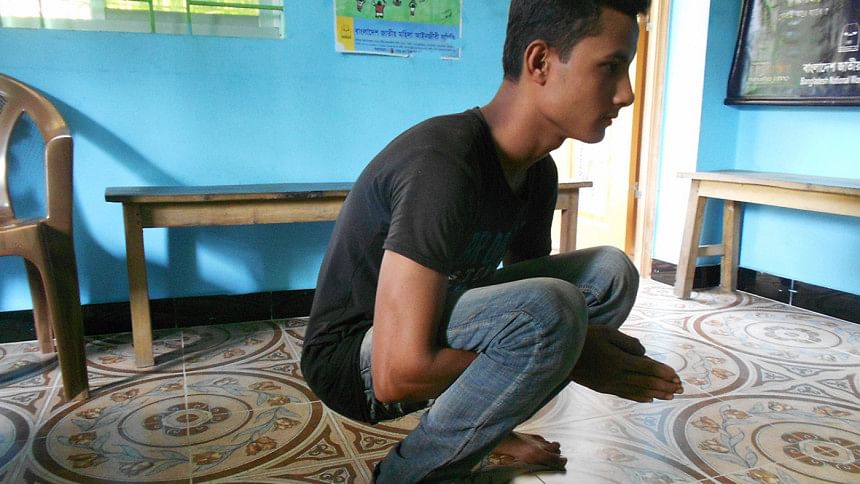Kidnapped, turned into slaves of past

Jewel Barua was bound the way slaves from centuries past were.
"My arms and legs were tied in such a way that it was impossible for me even to change sides without help," said Jewel, who was abducted and held captive by human traffickers in November last year.
The 22-year-old, along with 13 others, was confined to a shack for a day in Teknaf's Noapara before being sent to Malaysia for slave labour through Thailand and the Bay of Bengal.
A man carrying a stick stood guard inside the shack and hit them whenever they tried to talk with each other.
A lack of statistics makes it difficult to get an idea of how many people are victims of trafficking each year, but Teknaf and the rest of the coastal areas have been gripped by a sense of insecurity over the number of cases.
Mohammad Alam, a shopkeeper at St Martin's Island, sensed that fear recently.
"I went to Teknaf to buy goods for my grocery shop," Alam said. "It was already dark when I reached Teknaf. I didn't dare go out of the hotel the whole evening and night. I was afraid I would be abducted if I went out after dark."
The fear is based on cases like Jewel's. He said the captives felt so miserable they begged their captors to send them to Malaysia instead of torturing them.
"We told the guard that if we were to die, we would prefer to perish in the sea," said Jewel, who works at a mechanical shop. "Death there would be much better than being tied and beaten this way. We were untied only once a day to eat our meagre diet of bread and flattened rice."
Read all stories of "Dark Triangle" series-
- Slave Trade Booms In Dark Triangle
- Kidnapped, treated like slaves of past
- 'MALAYSIA AIRPORTS' in Teknaf
- Sailing off into hell
- Illegally driven as legally restricted
- One broker an upazila's woe
- Kidnapped, turned into slaves of past
Before they ate, according to Jewel, the guards would say: "You must finish the meal in 10 minutes ... don't even think of refusing it. Your death means a big financial loss for us."

He and the other 13 abductees were bundled into a boat that left Teknaf's Kochubuniya for Thailand on November 31 last year. Jewel was rescued from a Thai jungle on January 26, but the fate of the other 13 is still unknown.
Investigations revealed that many construction and cultivation labourers fall victim to abduction. Human traffickers use various tricks to lure people into their traps.
Jewel's neighbour Anancha Barua tricked him into travelling to Noapara, saying one of his friends there was looking for a mechanic. Jewel took a three-hour bus ride from his home in Ukhia and fell straight into the traffickers' trap.
In a similar way, human traffickers tricked Mohammad Ismail, a house painter in Ukhia, by promising him higher pay.
Ismail's friend Osman told him to see a person in Teknaf to get work. As he went to the address provided by Osman, several traffickers lurking there beat him up and kept him confined for days.
Ismail, 23, was forced into a boat to Thailand early last year. He was rescued by Thai police in January.
Children at risk
A great amount of trafficking victims are children. For example, two Madrasa students were abducted by human traffickers in Teknaf.
Ibrahim and Yusuf, both students of Al-jamia Al-Ashrafia Kashemul Ulum Madrasa, were lured into a trap by their classmate Mohammad Ali, 15.
Ali gave them false hope about becoming rich. He said all they needed to do was take a boat to Malaysia and work there for a few years.
Ali took the two to the house of broker Mohammad Hossain on November 14. Ali got Tk 40,000 from Hossain for handing over his two classmates.
Hossain then hired an auto rickshaw and brought the boys to the house of human trafficker Khuilla Mia at Quainchhori in Teknaf.
"I sensed trouble the moment I entered Khuilla's house around 7 p.m. that day," Ibrahim said.
When Ibrahim told Khuilla that he was no longer interested in travelling to Malaysia, the trafficker and his accomplices beat him up and kept the boys confined in a shack.
"I screamed, kicked the door of the house, and eventually made an escape," Ibrahim said.
As he ran away, he found a shop and phoned his father, Faridul Alam, a village doctor.
But Khuilla and his cohorts chased him down and took him back to confinement around 8 p.m. They roughed him up and threatened to kill him.
Acting on information from Ibrahim's father, a team of Bangladesh border guards raided Khuilla's house about three hours later and rescued the boys.
Making false promises, human traffickers trapped another boy, Mohammad Ismail, a seventh-grade student of Goyalmara Dakhil Madrasa, in Ukhia last month.
The 17-year-old was tricked by his neighbours Shafi Alam and Ramzan Ali, who took him to a house in Paschim Sonapara in an auto rickshaw on November 9 to send him to Malaysia as slave labour.
Ismail's mother, Monwara Begum, heard about it from neighbours.
Three days later, the boy's parents got a phone call from the abductors, who asked them to pay the duo a ransom of Tk 50,000 to get their son back.
Finally, Ismail's parents informed the police on November 22 and filed an abduction case against Shafi and Ramzan. Ismail still hasn't been found.
Enslavement by abduction was commonplace during the days of legal slavery. The history of slavery predates written record. Civilizations were built mainly on the labor of slaves. At least 1.7 million Africans were abducted during the transatlantic slave trade. But the life-altering, violent practice continues today.
*Copyright: The Daily Star/Asia News Network

 For all latest news, follow The Daily Star's Google News channel.
For all latest news, follow The Daily Star's Google News channel. 



Comments